Influence of Rapid Heat Treatment on the Photocatalytic Activity and Stability of Strontium Titanates against a Broad Range of Pollutants
Abstract
1. Introduction
2. Results and Discussion
2.1. Characterization of the Photocatalysts
2.2. Photocatalytic Activity Measurements
2.3. XPS and IR Measurements
2.4. Stability Measurements
2.5. Cost Efficiency Comparison of Conventional Calcination and RHSE Method
- Sample surface of 1 cm2 and depth of 1 mm;
- Heat transfer is achieved via convection (due to the introduction of air);
- Natural convection is neglectable due to the experimental conditions (indicated by the Nusselt and Reynolds numbers of the system);
- Local heat transfer occurs only on the surface;
- The preparation of STO_RHSE_700 and STO_700 by conventional calcination requires the same starting materials; thus, chemistry-related issues (enthalpy, entropy, heat conduction, specific heat capacity, etc.) can be ruled out.
3. Materials and Methods
3.1. Materials
3.2. Synthesis
3.3. Characterization Methods and Instrumentation
3.4. Photocatalytic Activity and Stability Measurements
4. Conclusions
Supplementary Materials
Author Contributions
Funding
Data Availability Statement
Conflicts of Interest
References
- Atkinson, I.; Parvulescu, V.; Cusu, J.P.; Anghel, E.; Voicescu, M.; Culita, D.; Somacescu, S.; Munteanu, C.; Šćepanović, M.; Popovic, Z. Influence of preparation method and nitrogen (N) doping on properties and photo-catalytic activity of mesoporous SrTiO3. J. Photochem. Photobiol. A 2019, 368, 41–51. [Google Scholar] [CrossRef]
- Ganapathy, M.; Hsu, Y.; Thomas, J.; Chang, C.T.; Alagan, V. Co-catalyst free SrTiO3 nano-cube for efficient photocatalytic hydrogen production. J. Mater. Sci. 2021, 56, 18976–18988. [Google Scholar] [CrossRef]
- da Silva, L.F.; Lopes, O.F.; de Mendonça, V.R.; Carvalho, K.T.; Longo, E.; Ribeiro, C.; Mastelaro, V.R. An understanding of the photocatalytic properties and pollutant degradation mechanism of SrTiO3 nanoparticles. Photochem. Photobiol. 2016, 92, 371–378. [Google Scholar] [CrossRef] [PubMed]
- Song, Y.-X.; Ma, W.-Q.; Chen, J.-J.; Xu, J.; Mao, Z.-Y.; Wang, D.-J. Photocatalytic activity of perovskite SrTiO3 catalysts doped with variable rare earth ions. Rare Met. 2021, 40, 1077–1085. [Google Scholar] [CrossRef]
- Jia, A.; Liang, X.; Su, Z.; Zhu, T.; Liu, S. Synthesis and the effect of calcination temperature on the physical–chemical properties and photocatalytic activities of Ni, La codoped SrTiO3. J. Hazard. Mater. 2010, 178, 233–242. [Google Scholar] [CrossRef]
- Asahi, R.; Morikawa, T.; Ohwaki, T.; Aoki, K.; Taga, Y. Visible-light photocatalysis in nitrogen-doped titanium oxides. Science 2001, 293, 269–271. [Google Scholar] [CrossRef]
- Irie, H.; Watanabe, Y.; Hashimoto, K. Nitrogen-concentration dependence on photocatalytic activity of TiO2-xNx powders. J. Phys. Chem. B 2003, 107, 5483–5486. [Google Scholar] [CrossRef]
- Umebayashi, T.; Yamaki, T.; Tanaka, S.; Asai, K. Visible light-induced degradation of methylene blue on S-doped TiO2. Chem. Lett. 2003, 32, 330–331. [Google Scholar] [CrossRef]
- Liu, J.; Chen, G.; Li, Z.; Zhang, Z. Electronic structure and visible light photocatalysis water splitting property of chromium-doped SrTiO3. J. Solid State Chem. 2006, 179, 3704–3708. [Google Scholar] [CrossRef]
- Irie, H.; Maruyama, Y.; Hashimoto, K. Ag+- and Pb2+-doped SrTiO3 photocatalysts. A correlation between band structure and photocatalytic activity. J. Phys. Chem. C 2007, 111, 1847–1852. [Google Scholar] [CrossRef]
- Nakamura, I.; Negishi, N.; Kutsuna, S.; Ihara, T.; Sugihara, S.; Takeuchi, K. Role of oxygen vacancy in the plasma-treated TiO2 photocatalyst with visible light activity for NO removal. J. Mol. Catal. A Chem. 2000, 161, 205–212. [Google Scholar] [CrossRef]
- Dozzi, M.V.; Saccomanni, A.; Altomare, M.; Selli, E. Photocatalytic activity of NH4F-doped TiO2 modified by noble metal nanoparticle deposition. Photochem. Photobiol. Sci. 2013, 12, 595–601. [Google Scholar] [CrossRef]
- Tang, B.; Chen, H.; Peng, H.; Wang, Z.; Huang, W. Graphene modified TiO2 composite photocatalysts: Mechanism, progress and perspective. Nanomaterials 2018, 8, 105. [Google Scholar] [CrossRef]
- Sewvandi, G.A.; Tao, Z.; Kusunose, T.; Tanaka, Y.; Nakanishi, S.; Feng, Q. Modification of TiO2 electrode with organic silane interposed layer for high-performance of dye-sensitized solar cells. ACS Appl. Mater. Interfaces 2014, 6, 5818–5826. [Google Scholar] [CrossRef]
- Gholamrezaei, S.; Salavati Niasari, M.; Dadkhah, M.; Sarkhosh, B. New modified sol–gel method for preparation SrTiO3 nanostructures and their application in dye-sensitized solar cells. J. Mater. Sci. Mater. Electron. 2016, 27, 118–125. [Google Scholar] [CrossRef]
- Kiran, K.; Ashwath Narayana, B.; Lokesh, S. Enhanced photocatalytic activity of perovskite SrTiO3 nanorods. Solid State Technol. 2020, 63, 1913–1920. [Google Scholar]
- Pap, Z.; Karácsonyi, É.; Cegléd, Z.; Dombi, A.; Danciu, V.; Popescu, I.; Baia, L.; Oszkó, A.; Mogyorósi, K. Dynamic changes on the surface during the calcination of rapid heat treated TiO2 photocatalysts. Appl. Catal. B Environ. 2012, 111, 595–604. [Google Scholar] [CrossRef]
- Wu, Y.; Li, M.; Yuan, J.; Wang, X. Low temperature synthesis and photocatalytic performances of pure Bi2SiO5 powders via pechini sol–gel method. J. Mater. Sci. Mater. Electron. 2017, 28, 10406–10410. [Google Scholar] [CrossRef]
- Wattanathana, W.; Nantharak, W.; Wannapaiboon, S.; Jantaratana, P.; Veranitisagul, C.; Koonsaeng, N.; Laobuthee, A. Barium ferrite prepared by modified Pechini method: Effects of chloride and nitrate counter ions on microstructures and magnetic properties. J. Mater. Sci. Mater. Electron. 2018, 29, 1542–1553. [Google Scholar] [CrossRef]
- Fuentes, S.; Zarate, R.; Chavez, E.; Munoz, P.; Díaz-Droguett, D.; Leyton, P. Preparation of SrTiO3 nanomaterial by a sol–gel-hydrothermal method. J. Mater. Sci. 2010, 45, 1448–1452. [Google Scholar] [CrossRef]
- Veréb, G.; Gyulavári, T.; Pap, Z.; Baia, L.; Mogyorósi, K.; Dombi, A.; Hernádi, K. Visible light driven photocatalytic elimination of organic-and microbial pollution by rutile-phase titanium dioxides: New insights on the dynamic relationship between morpho-structural parameters and photocatalytic performance. RSC Adv. 2015, 5, 66636–66643. [Google Scholar] [CrossRef]
- Pap, Z.; Danciu, V.; Cegléd, Z.; Kukovecz, Á.; Oszkó, A.; Dombi, A.; Mogyorósi, K. The influence of rapid heat treatment in still air on the photocatalytic activity of titania photocatalysts for phenol and monuron degradation. Appl. Catal. B Environ. 2011, 101, 461–470. [Google Scholar] [CrossRef]
- Mogyorósi, K.; Karácsonyi, E.; Cegléd, Z.; Dombi, A.; Danciu, V.; Baia, L.; Pap, Z. New insights regarding the calcination as a critical parameter in the synthesis of sol–gel made titania powders. J. Sol-Gel Sci. Technol. 2013, 65, 277–282. [Google Scholar] [CrossRef]
- Gyulavári, T.; Veréb, G.; Pap, Z.; Dombi, A.; Hernádi, K. Associating low crystallinity with peroxo groups for enhanced visible light active photocatalysts. Catal. Today 2018, 313, 231–238. [Google Scholar] [CrossRef]
- Tóth, Z.-R.; Maity, S.K.; Gyulavári, T.; Bárdos, E.; Baia, L.; Kovács, G.; Garg, S.; Pap, Z.; Hernadi, K. Solvothermal Crystallization of Ag/AgxO-AgCl Composites: Effect of Different Chloride Sources/Shape-Tailoring Agents. Catalysts 2021, 11, 379. [Google Scholar] [CrossRef]
- Jin, S.; Dong, G.; Luo, J.; Ma, F.; Wang, C. Improved photocatalytic NO removal activity of SrTiO3 by using SrCO3 as a new co-catalyst. Appl. Catal. B Environ. 2018, 227, 24–34. [Google Scholar] [CrossRef]
- Wang, Y.; Yang, X.; Hou, C.; Yin, F.; Wang, G.; Zhu, X.; Jiang, G.; Li, C. Improved Catalytic Activity and Stability of Ba Substituted SrTiO3 Perovskite for Oxidative Coupling of Methane. ChemCatChem 2021, 13, 4182–4191. [Google Scholar]
- Le, M.-V.; Vo, N.-Q.-D.; Le, Q.-C.; Tran, V.A.; Phan, T.-Q.-P.; Huang, C.-W.; Nguyen, V.-H. Manipulating the structure and characterization of Sr1−x LaxTiO3 nanocubes toward the photodegradation of 2-naphthol under artificial solar light. Catalysts 2021, 11, 564. [Google Scholar] [CrossRef]
- Gyulavári, T.; Dusnoki, D.; Márta, V.; Yadav, M.; Abedi, M.; Sápi, A.; Kukovecz, Á.; Kónya, Z.; Pap, Z. Dependence of Photocatalytic Activity on the Morphology of Strontium Titanates. Catalysts 2022, 12, 523. [Google Scholar] [CrossRef]
- Asgari-Fard, Z.; Sabet, M.; Salavati-Niasari, M. Synthesis and characterization of strontium carbonate nanostructures via simple hydrothermal method. High Temp. Mater. Process. 2016, 35, 215–220. [Google Scholar] [CrossRef]
- Da Silva, L.F.; Maia, L.; Bernardi, M.I.B.; Andres, J.; Mastelaro, V.R. An improved method for preparation of SrTiO3 nanoparticles. Mater. Chem. Phys. 2011, 125, 168–173. [Google Scholar] [CrossRef]
- Tunç Parlak, T.; Apaydin, F.; Yildiz, K. Formation of SrTiO3 in mechanically activated SrCO3–TiO2 system. J. Therm. Anal. Calorim. 2017, 127, 63–69. [Google Scholar] [CrossRef]
- Kudo, A.; Tanaka, A.; Domen, K.; Onishi, T. The effects of the calcination temperature of SrTiO3 powder on photocatalytic activities. J. Catal. 1988, 111, 296–301. [Google Scholar] [CrossRef]
- Chen, L.; Zhang, S.; Wang, L.; Xue, D.; Yin, S. Preparation and photocatalytic properties of strontium titanate powders via sol–gel process. J. Cryst. Growth 2009, 311, 746–748. [Google Scholar] [CrossRef]
- Xiong, L.; Li, J.; Yang, B.; Yu, Y. Ti3+ in the Surface of Titanium Dioxide: Generation, Properties and Photocatalytic Application. J. Nanomater. 2012, 2012, 9. [Google Scholar] [CrossRef]
- Jiang, D.; Sun, X.; Wu, X.; Shi, L.; Du, F. Hydrothermal synthesis of single-crystal Cr-doped SrTiO3 for efficient visible-light responsive photocatalytic hydrogen evolution. Mater. Res. Express 2020, 7, 015047. [Google Scholar] [CrossRef]
- Zhou, M.; Chen, J.; Zhang, Y.; Jiang, M.; Xu, S.; Liang, Q.; Li, Z. Shape-controlled synthesis of golf-like, star-like, urchin-like and flower-like SrTiO3 for highly efficient photocatalytic degradation and H2 production. J. Alloys Compd. 2020, 817, 152796. [Google Scholar] [CrossRef]
- Gyulavári, T.; Pap, Z.; Kovács, G.; Baia, L.; Todea, M.; Hernádi, K.; Veréb, G. Peroxo group enhanced nanorutile as visible light active photocatalyst. Catal. Today 2017, 284, 129–136. [Google Scholar] [CrossRef]
- Roque-Ruiz, J.; Meraz-Angel, J.; Farias, R.; Meléndez-Lira, M.; Reyes-López, S. Sol-gel synthesis of strontium titanate nanofibers by electrospinning. J. Ceram. Sci. Technol. 2019, 10, 29–38. [Google Scholar]
- Wang, Z.; Jiang, S.; Li, G.; Xi, M.; Li, T. Synthesis and characterization of Ba1−xSrxTiO3 nanopowders by citric acid gel method. Ceram. Int. 2007, 33, 1105–1109. [Google Scholar] [CrossRef]
- Xian, T.; Yang, H.; Di, L.; Ma, J.; Zhang, H.; Dai, J. Photocatalytic reduction synthesis of SrTiO3-graphene nanocomposites and their enhanced photocatalytic activity. Nanoscale Res. Lett. 2014, 9, 327. [Google Scholar] [CrossRef] [PubMed]
- Lu, P.; Hu, X.; Li, Y.; Zhang, M.; Liu, X.; He, Y.; Dong, F.; Fu, M.; Zhang, Z. One-step preparation of a novel SrCO3/gC3N4 nano-composite and its application in selective adsorption of crystal violet. RSC Adv. 2018, 8, 6315–6325. [Google Scholar] [CrossRef] [PubMed]
- Boga, B.; Steinfeldt, N.; Moustakas, N.G.; Peppel, T.; Lund, H.; Rabeah, J.; Pap, Z.; Cristea, V.-M.; Strunk, J. Role of SrCO3 on Photocatalytic Performance of SrTiO3-SrCO3 Composites. Catalysts 2022, 12, 978. [Google Scholar] [CrossRef]
- Ciliberto, E.; Condorelli, G.; La Delfa, S.; Viscuso, E. Nanoparticles of Sr(OH)2: Synthesis in homogeneous phase at low temperature and application for cultural heritage artefacts. Appl. Phys. A 2008, 92, 137–141. [Google Scholar] [CrossRef]
- Zhang, L.; Li, N.; Wang, H.-Q.; Zhang, Y.; Ren, F.; Liao, X.-X.; Li, Y.-P.; Wang, X.-D.; Huang, Z.; Dai, Y. Tuning the thermal conductivity of strontium titanate through annealing treatments. Chin. Phys. B 2017, 26, 016602. [Google Scholar] [CrossRef]
- Lu, X.; Pine, T.S.; Mumm, D.R.; Brouwer, J. Modified Pechini synthesis and characterization of Y-doped strontium titanate perovskite. Solid State Ion. 2007, 178, 1195–1199. [Google Scholar] [CrossRef]
- Jenkins, R.; Snyder, R.L. Introduction to X-ray Powder Diffractometry; Wiley Online Library: Hoboken, NJ, USA, 1996; Volume 138. [Google Scholar]
- Leite, E.R.; Nobre, M.A.; Cerqueira, M.; Longo, E.; Varela, J.A. Particle growth during calcination of polycation oxides synthesized by the polymeric precursors method. J. Am. Ceram. Soc. 1997, 80, 2649–2657. [Google Scholar] [CrossRef]
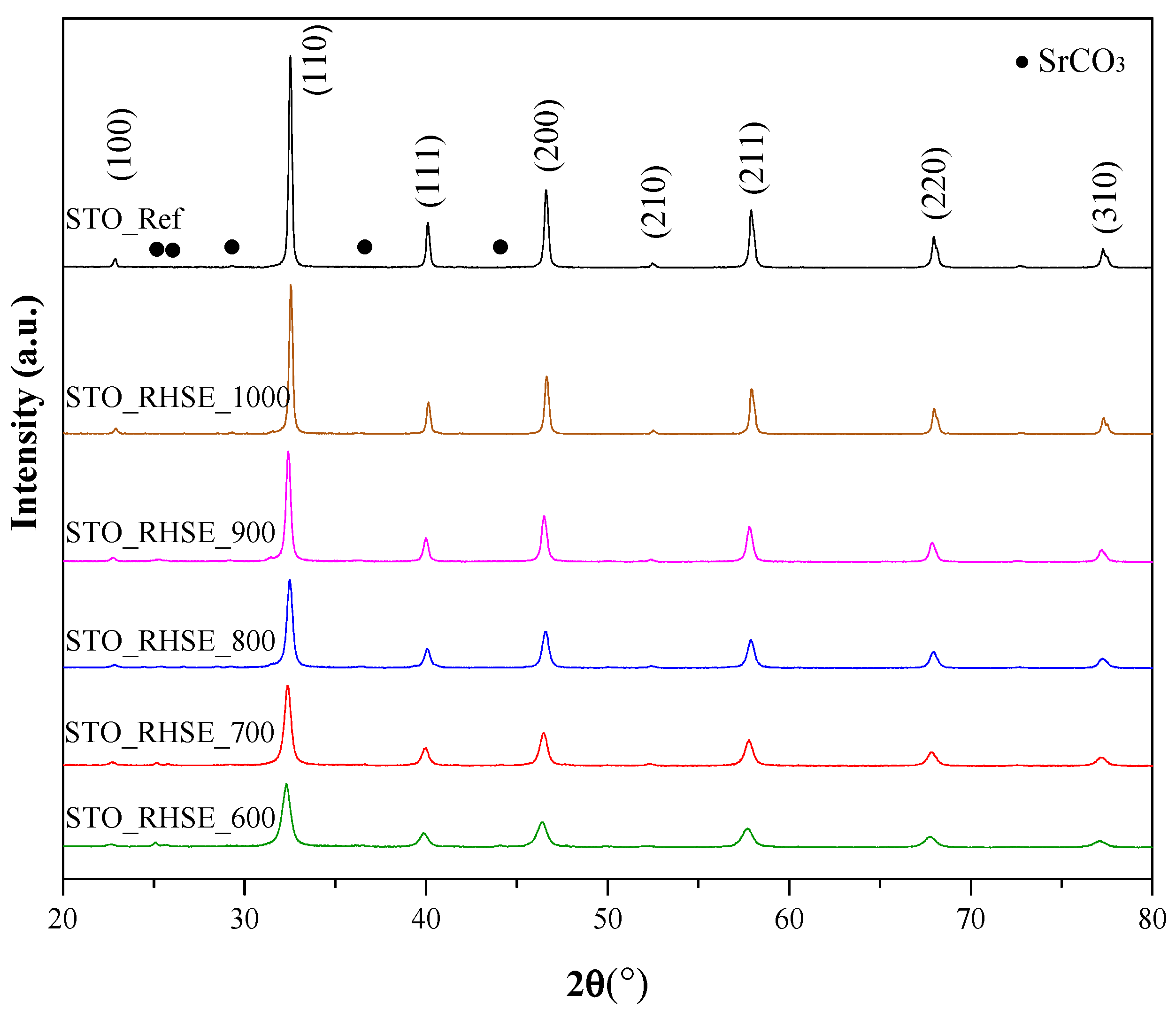
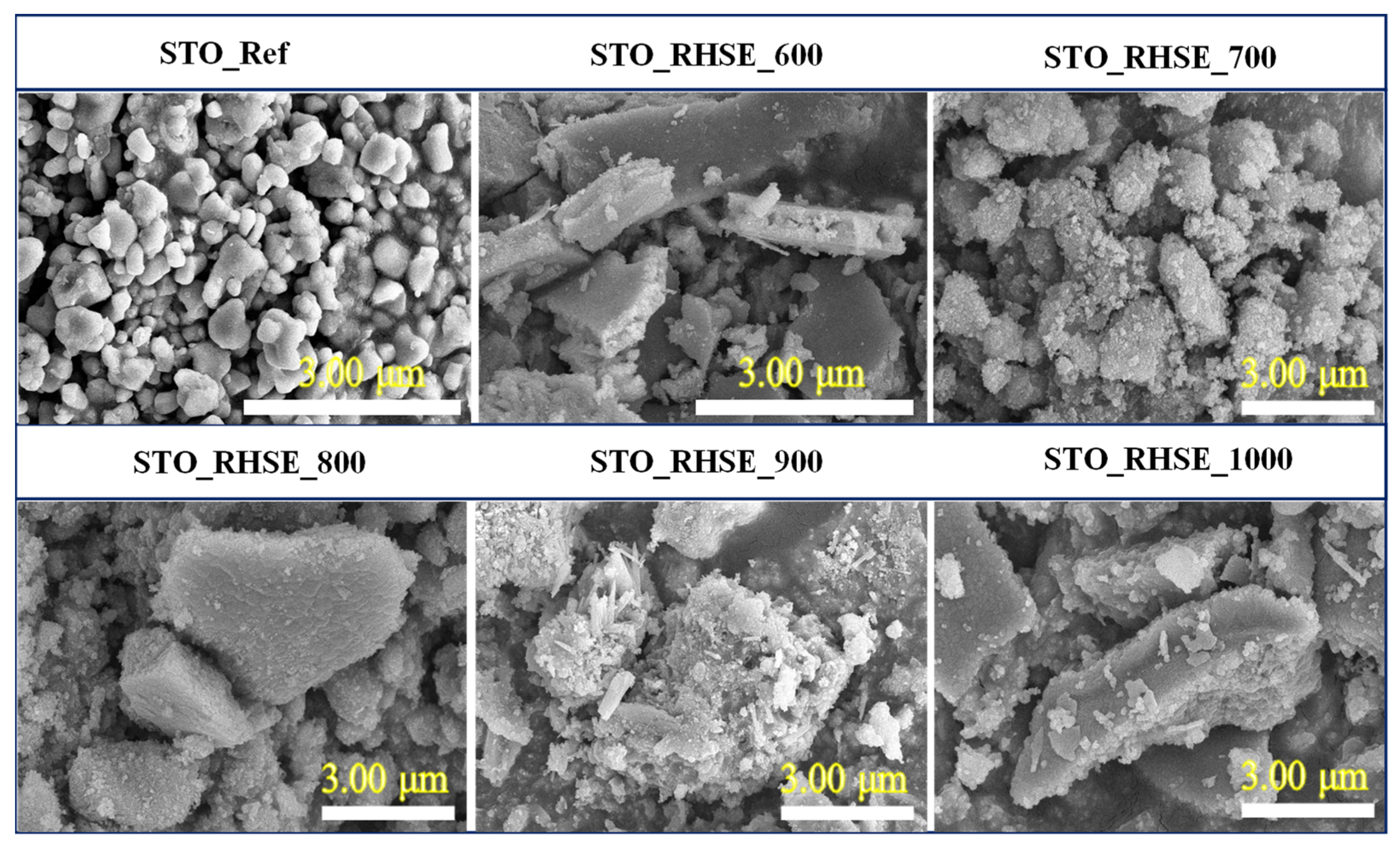
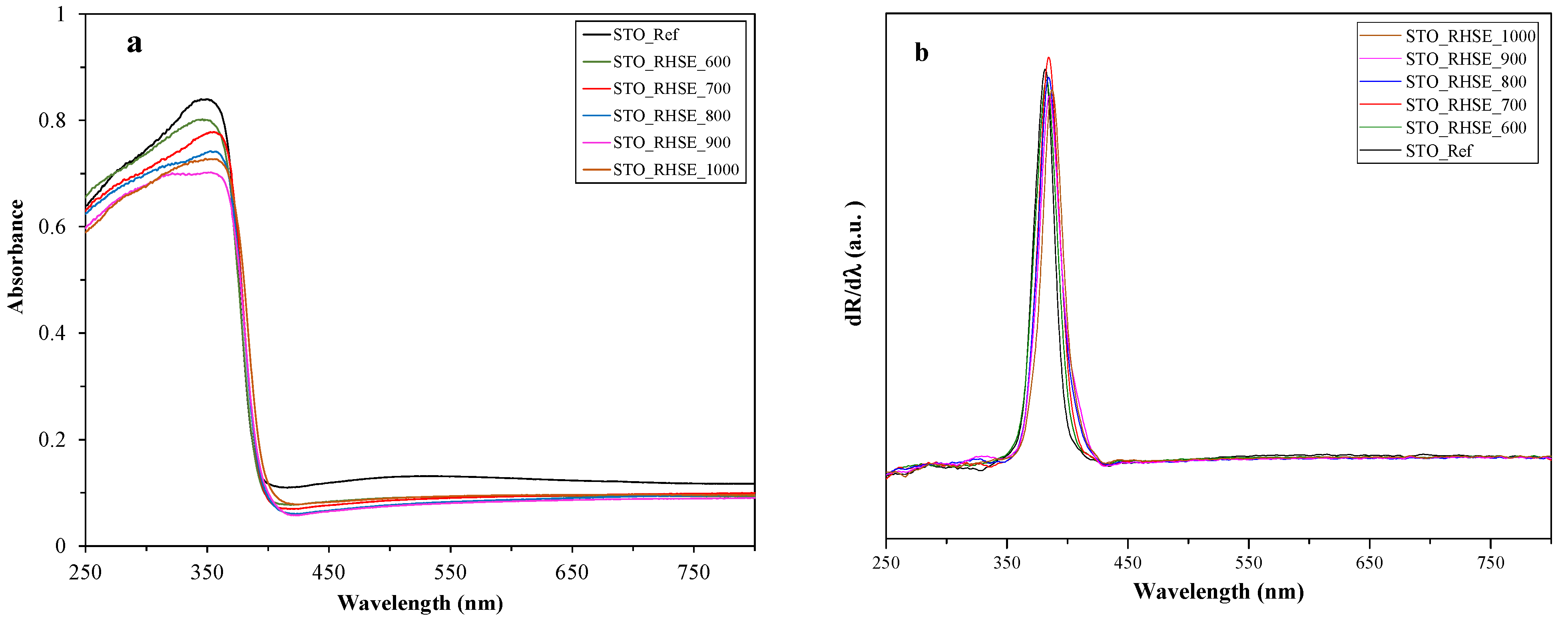
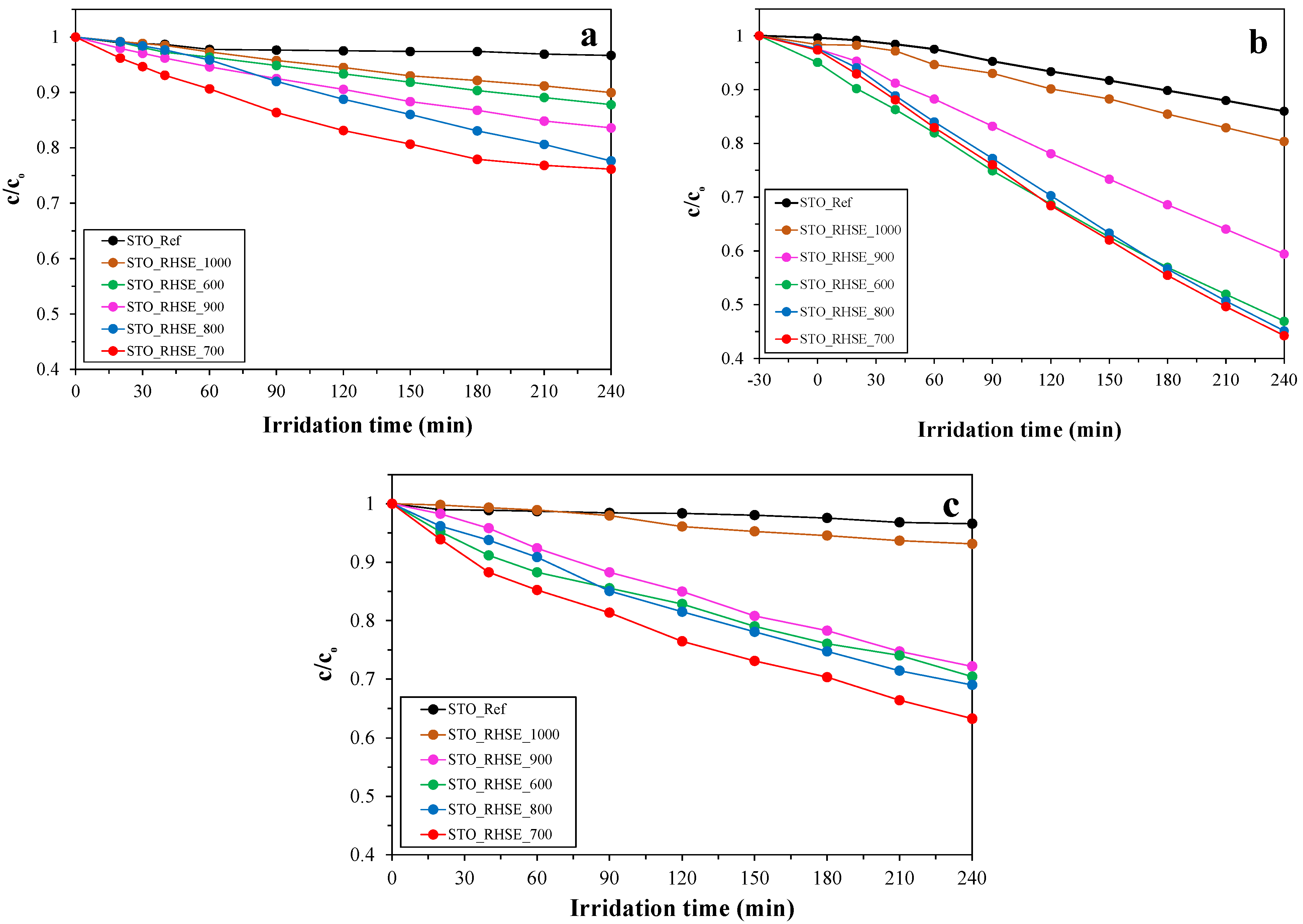
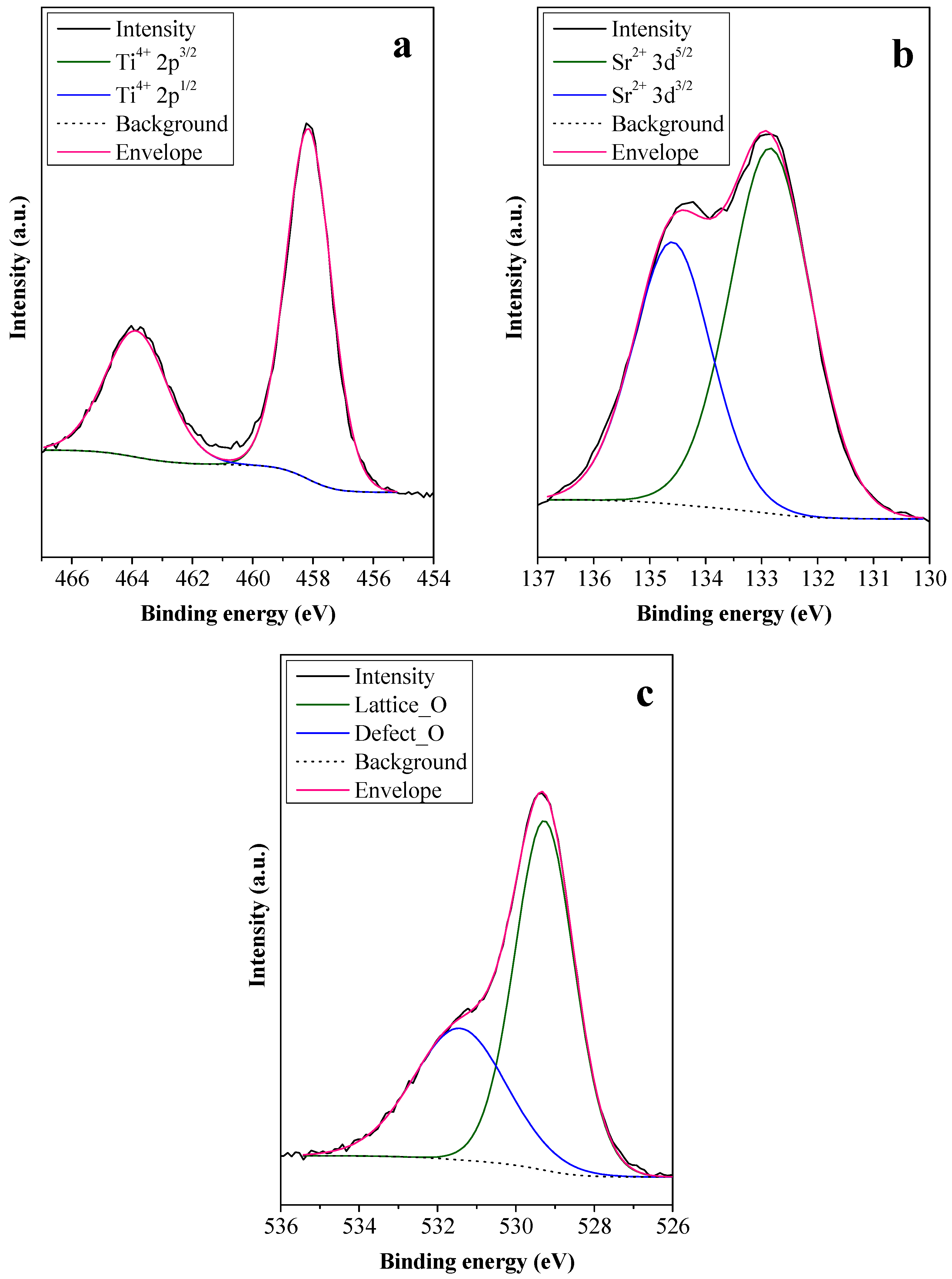
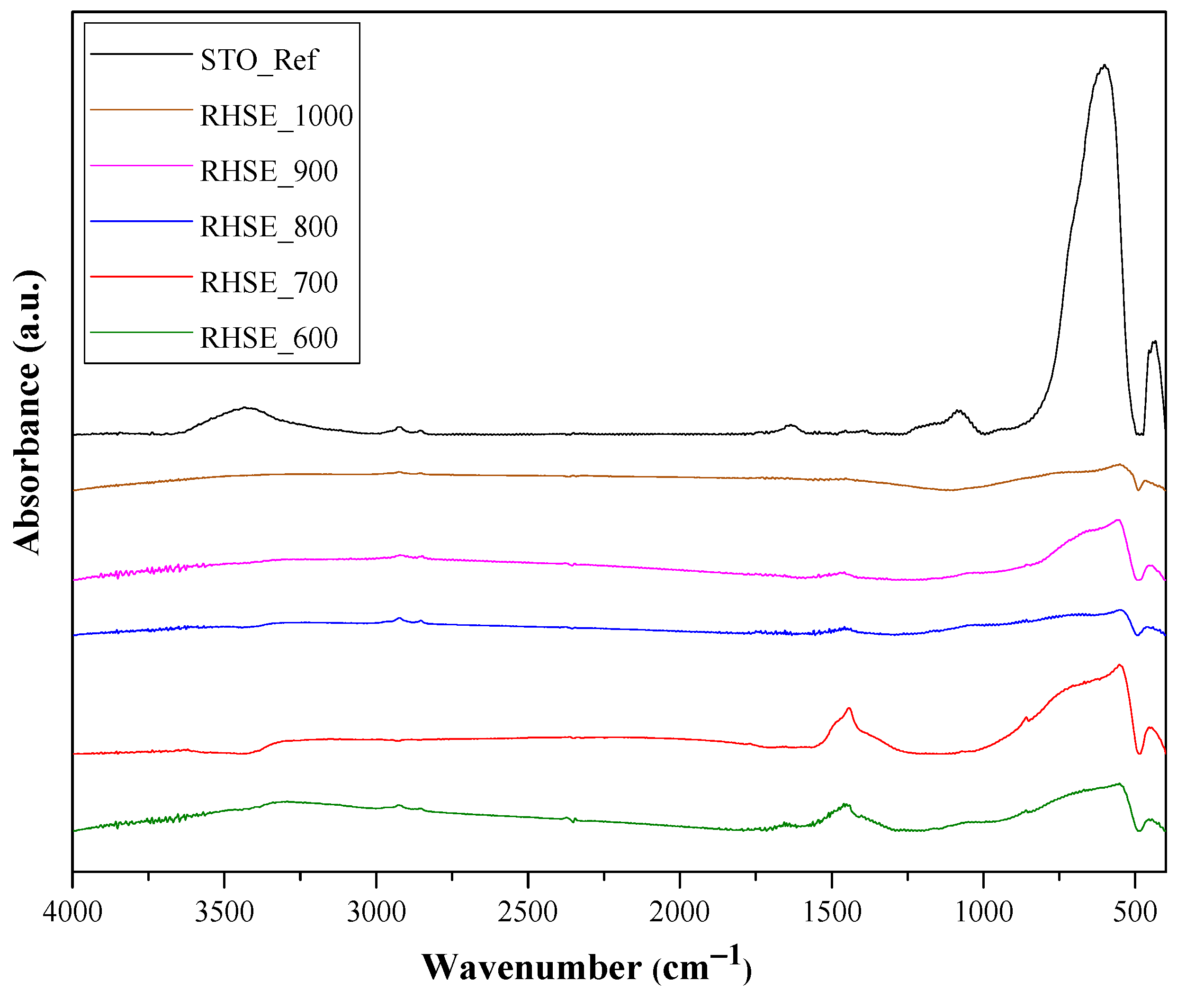
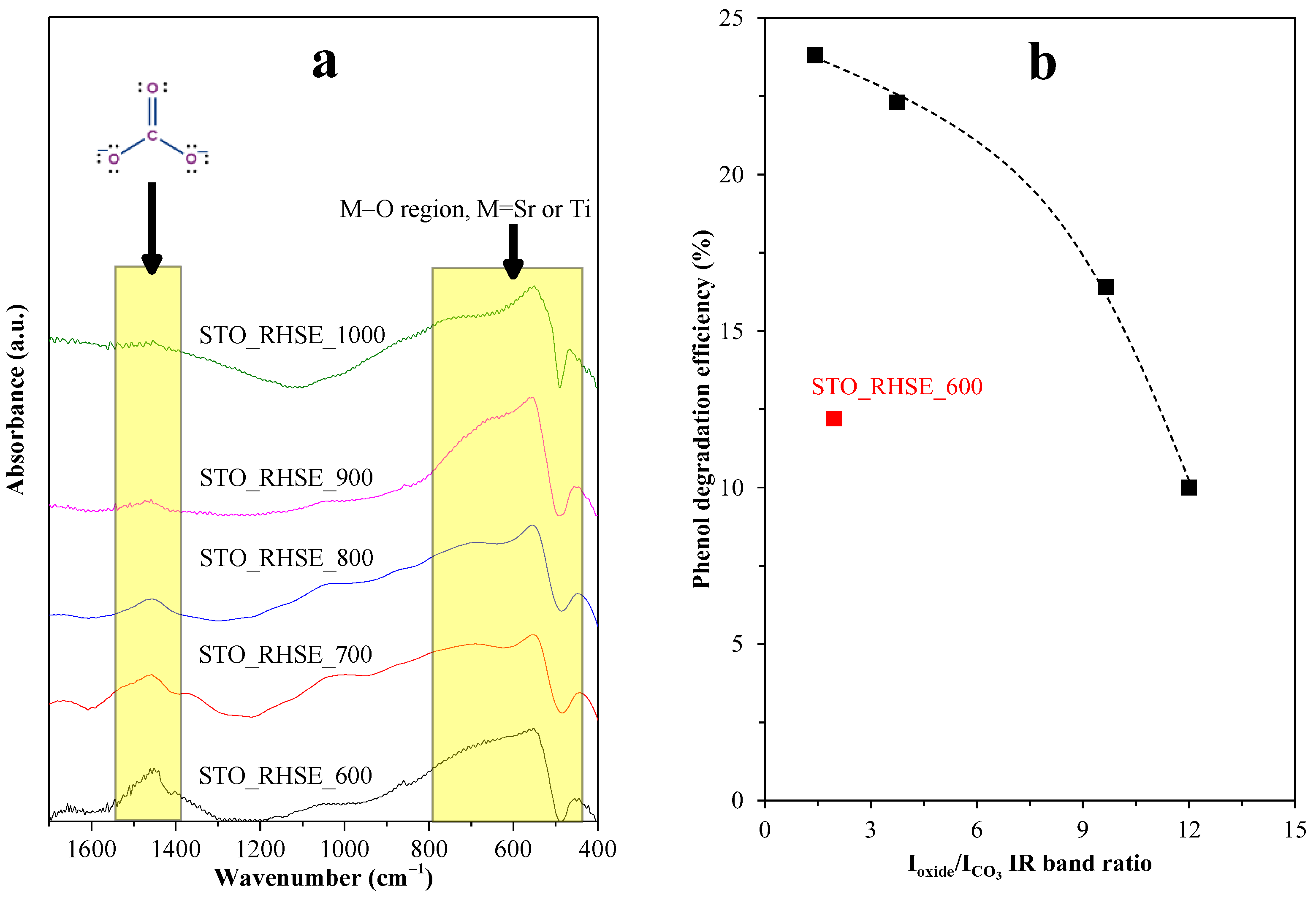
| Sample Name | Crystallite Size (nm) | Specific Surface Area (m2 g−1) | Band Gap (eV) | 1 TORS (μmol∙m−2∙h−1) | ||
|---|---|---|---|---|---|---|
| Phenol | Oxalic Acid | Chlorophenol | ||||
| STO_RHSE_600 | 14.7 | 54.5 | 3.25 | 1.4 | 3.3 | 1.9 |
| STO_RHSE_700 | 18.7 | 42.9 | 3.23 | 1.5 | 3.6 | 2.3 |
| STO_RHSE_800 | 22.6 | 36.3 | 3.23 | 2.2 | 3.6 | 2.1 |
| STO_RHSE_900 | 26.5 | 18.7 | 3.22 | 1.2 | 2.6 | 2.0 |
| STO_RHSE_1000 | 33.1 | 4.3 | 3.20 | 8.1 | 1.2 | 5.2 |
| STO_Ref | 39.2 | 2.1 | 3.25 | 1.8 | 9.6 | 2.0 |
Disclaimer/Publisher’s Note: The statements, opinions and data contained in all publications are solely those of the individual author(s) and contributor(s) and not of MDPI and/or the editor(s). MDPI and/or the editor(s) disclaim responsibility for any injury to people or property resulting from any ideas, methods, instructions or products referred to in the content. |
© 2023 by the authors. Licensee MDPI, Basel, Switzerland. This article is an open access article distributed under the terms and conditions of the Creative Commons Attribution (CC BY) license (https://creativecommons.org/licenses/by/4.0/).
Share and Cite
Abedi, M.; Szamosvölgyi, Á.; Sápi, A.; Kukovecz, Á.; Kónya, Z.; Gyulavári, T.; Pap, Z. Influence of Rapid Heat Treatment on the Photocatalytic Activity and Stability of Strontium Titanates against a Broad Range of Pollutants. Catalysts 2023, 13, 219. https://doi.org/10.3390/catal13020219
Abedi M, Szamosvölgyi Á, Sápi A, Kukovecz Á, Kónya Z, Gyulavári T, Pap Z. Influence of Rapid Heat Treatment on the Photocatalytic Activity and Stability of Strontium Titanates against a Broad Range of Pollutants. Catalysts. 2023; 13(2):219. https://doi.org/10.3390/catal13020219
Chicago/Turabian StyleAbedi, Mahsa, Ákos Szamosvölgyi, András Sápi, Ákos Kukovecz, Zoltán Kónya, Tamás Gyulavári, and Zsolt Pap. 2023. "Influence of Rapid Heat Treatment on the Photocatalytic Activity and Stability of Strontium Titanates against a Broad Range of Pollutants" Catalysts 13, no. 2: 219. https://doi.org/10.3390/catal13020219
APA StyleAbedi, M., Szamosvölgyi, Á., Sápi, A., Kukovecz, Á., Kónya, Z., Gyulavári, T., & Pap, Z. (2023). Influence of Rapid Heat Treatment on the Photocatalytic Activity and Stability of Strontium Titanates against a Broad Range of Pollutants. Catalysts, 13(2), 219. https://doi.org/10.3390/catal13020219













